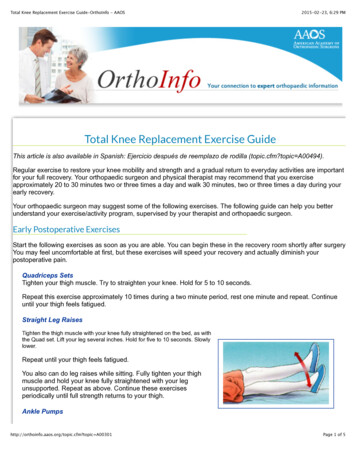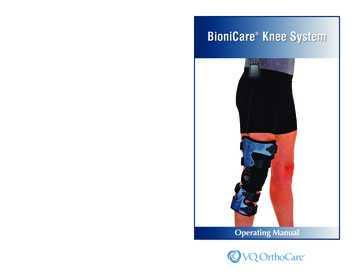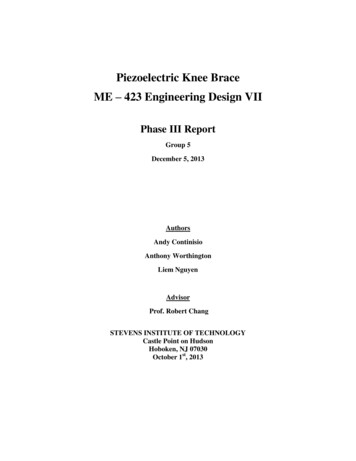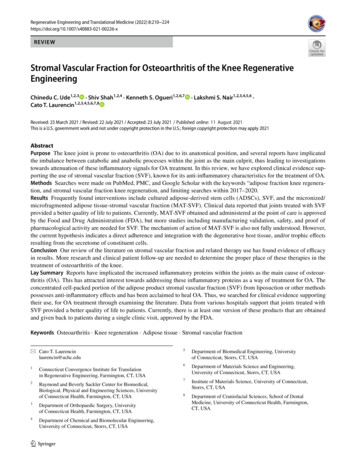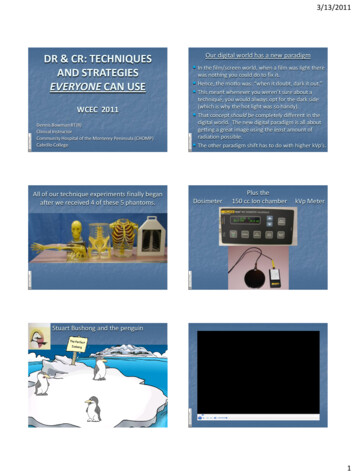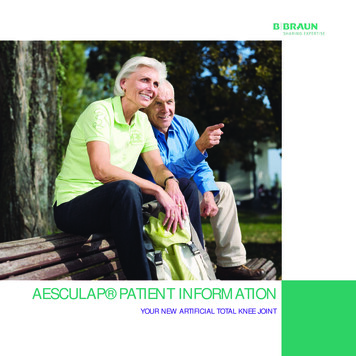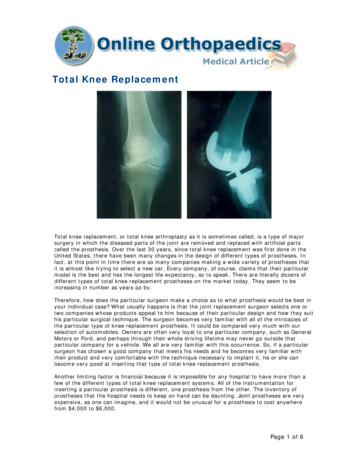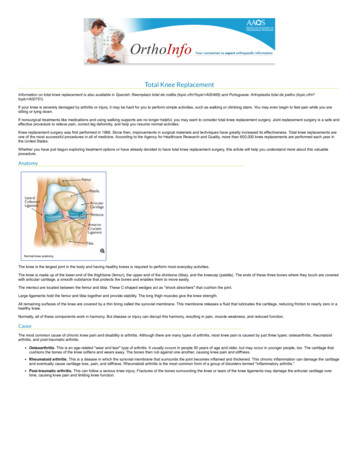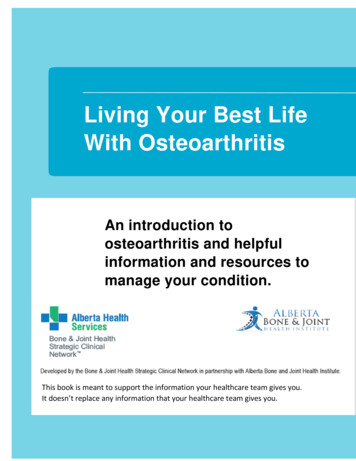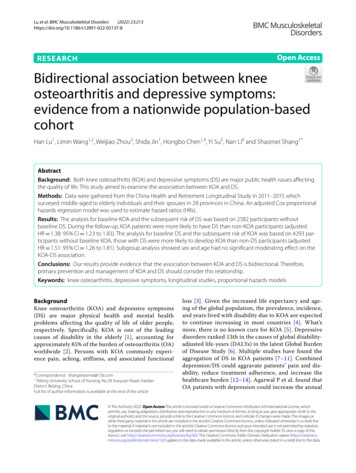
Transcription
(2022) 23:213Lu et al. BMC Musculoskeletal 8Open AccessRESEARCHBidirectional association between kneeosteoarthritis and depressive symptoms:evidence from a nationwide population-basedcohortHan Lu1, Limin Wang1,2, Weijiao Zhou3, Shida Jin1, Hongbo Chen1,4, Yi Su5, Nan Li6 and Shaomei Shang1*AbstractBackground: Both knee osteoarthritis (KOA) and depressive symptoms (DS) are major public health issues affectingthe quality of life. This study aimed to examine the association between KOA and DS.Methods: Data were gathered from the China Health and Retirement Longitudinal Study in 2011–2015 whichsurveyed middle-aged to elderly individuals and their spouses in 28 provinces in China. An adjusted Cox proportionalhazards regression model was used to estimate hazard ratios (HRs).Results: The analysis for baseline KOA and the subsequent risk of DS was based on 2582 participants withoutbaseline DS. During the follow-up, KOA patients were more likely to have DS than non-KOA participants (adjustedHR 1.38: 95% CI 1.23 to 1.83). The analysis for baseline DS and the subsequent risk of KOA was based on 4293 participants without baseline KOA, those with DS were more likely to develop KOA than non-DS participants (adjustedHR 1.51: 95% CI 1.26 to 1.81). Subgroup analysis showed sex and age had no significant moderating effect on theKOA-DS association.Conclusions: Our results provide evidence that the association between KOA and DS is bidirectional. Therefore,primary prevention and management of KOA and DS should consider this relationship.Keywords: knee osteoarthritis, depressive symptoms, longitudinal studies, proportional hazards modelsBackgroundKnee osteoarthritis (KOA) and depressive symptoms(DS) are major physical health and mental healthproblems affecting the quality of life of older people,respectively. Specifically, KOA is one of the leadingcauses of disability in the elderly [1], accounting forapproximately 85% of the burden of osteoarthritis (OA)worldwide [2]. Persons with KOA commonly experience pain, aching, stiffness, and associated functional*Correspondence: shangshaomei@126.com1Peking University School of Nursing, No.38 Xueyuan Road, HaidianDistrict, Beijing, ChinaFull list of author information is available at the end of the articleloss [3]. Given the increased life expectancy and ageing of the global population, the prevalence, incidence,and years lived with disability due to KOA are expectedto continue increasing in most countries [4]. What’smore, there is no known cure for KOA [5]. Depressivedisorders ranked 13th in the causes of global disabilityadjusted life-years (DALYs) in the latest Global Burdenof Disease Study [6]. Multiple studies have found theaggregation of DS in KOA patients [7–11]. Combineddepression/DS could aggravate patients’ pain and disability, reduce treatment adherence, and increase thehealthcare burden [12–14]. Agarwal P et al. found thatOA patients with depression could increase the annual The Author(s) 2022. Open Access This article is licensed under a Creative Commons Attribution 4.0 International License, whichpermits use, sharing, adaptation, distribution and reproduction in any medium or format, as long as you give appropriate credit to theoriginal author(s) and the source, provide a link to the Creative Commons licence, and indicate if changes were made. The images orother third party material in this article are included in the article’s Creative Commons licence, unless indicated otherwise in a credit lineto the material. If material is not included in the article’s Creative Commons licence and your intended use is not permitted by statutoryregulation or exceeds the permitted use, you will need to obtain permission directly from the copyright holder. To view a copy of thislicence, visit http:// creat iveco mmons. org/ licen ses/ by/4. 0/. The Creative Commons Public Domain Dedication waiver (http:// creat iveco mmons. org/ publi cdoma in/ zero/1. 0/) applies to the data made available in this article, unless otherwise stated in a credit line to the data.
Lu et al. BMC Musculoskeletal Disorders(2022) 23:213medical expenses by nearly US 4400 [15]. Therefore,it is necessary to pay more attention to the KOA withdepression/DS as a major public health issue.There are two possible explanations for the aggregation of DS in KOA patients: patients with KOA havea high risk to develop depression, or depressed persons are more likely to develop KOA. This has notbeen determined yet. On the one hand, DS is reportedly highly prevalent among KOA patients, and KOAhas been cited as a risk factor for developing DS [7–11]. On the other hand, some studies have shown thatpatients with DS are more likely to develop arthritis[11, 16]. Although many studies have explored thesingle-directional relationship between KOA and DS,whether the relationship between KOA and DS in bothdirections coexists in the same group is less verified.Moreover, most of the current studies were based onpopulation in developed countries, and there is a lackof evidence from China.To fill this gap, our study aimed to use data from amiddle-aged and elderly cohort to determine whetherthe association between KOA and DS is bidirectionaland the strength of association. Firstly, we analyzedthe effect of baseline KOA on the incidence of subsequent DS; secondly, we analyzed the effect of baselineDS on the incidence of subsequent KOA. Besides, weexplore the strength of these effects at different age,sex groups.MethodsParticipantsData for this study were gathered from the baselinesurvey in 2011 and two follow-up surveys in 2013 and2015 of the China Health and Retirement LongitudinalStudy (CHARLS). The CHARLS national survey useda multistage sampling strategy covering 28 provinces,150 counties or districts, and 450 villages or urbancommunities in China. Successfully interviewed 17,708individuals from 10,257 households, representing themiddle-aged and elderly people in China in general[17]. In the first analysis to predict the incidence of DS,participants were eligible if (i) they were 45 years old;(ii) they did not have DS at baseline; (iii) they were followed up for 1 year, and status of DS during follow-upwas recorded; (iv) they had complete baseline information (including KOA status and covariates). The second analysis to predict the incidence of KOA includedparticipants if (i) they were 45 years old; (ii) they didnot have KOA at baseline; (iii) they were followed upfor 1 year, and status of KOA during follow-up wasrecorded; (iv) they had complete baseline information(including DS status and covariates).Page 2 of 10MeasuresKOA onsetAll participants had a face-to-face household interviewusing a structured questionnaire. According to the definition in a previous study [18], KOA was identified by selfreported both physician-diagnosed osteoarthritis and thepresence of concurrent knee pain. Physicians who madethe diagnosis include internists, rheumatologists, orthopedic surgeons and doctors in Chinese medicine, and thediagnosis is often reached with the aid of X-rays [18, 19].Depressive symptomsDS was measured by the Chinese version of the Centerfor Epidemiologic Studies Depression (CES-D), a 10-itemquestionnaire with good reliability and validity (possiblerange, 0 30) [20]. The presence of DS was defined by aCES-D score of 10 or higher [20].CovariatesCovariates in the analysis included sociodemographiccharacteristics, lifestyle, and health-related factors atbaseline. All the variables were obtained from the 2011CHARLS survey. As described in previous studies [8, 21,22], the following factors were selected as covariates: a)sociodemographic characteristics: age, sex, marital status, education level, yearly income [23], and residence(urban, rural); b) lifestyle: smoking status, drinking status, length of sleep, physical activity (calculated usingmetabolic equivalent multiplied by activity weekly duration level) [24, 25]; c) health-related factors: whole healthand childhood health status (a 5-point Likert scale, wherehigher scores mean better health), body mass index(BMI), the number of difficulties with activities of dailyliving (ADL) [26] and instrumental activities of dailyliving (IADL) [27]. the number of non-communicablediseases (NCDs), experienced major accidental injuryor not, and C-reactive protein (CRP) [21]. Except forBMI and CRP were measured on site, all variables wereobtained from self-reported questionnaire data, and thedetailed information related to how each covariate wasassessed and the used tools is presented in Supplementary Table S1.Statistical analysisContinuous variables are reported as mean standarddeviation (SD), while categorical variables are expressedusing proportions. We used t-tests and chi-square teststo analyze differences among groups. We used Kaplan–Meier plots to show the incidence of DS by KOA ornon-KOA, and the incidence of KOA by DS or not. Logrank tests were used to compare the differences betweengroups. The duration of follow-up was defined as the date
Lu et al. BMC Musculoskeletal Disorders(2022) 23:213of the baseline interview to either the date of DS/KOAonset or the date of the last interview. The incidencedensity of KOA and DS was estimated by the number ofincident patients divided by the number of person-yearsaccumulated in the population. The proportional hazardsassumption was checked using the Schoenfeld residuals test. As the test results were reported as P 0.05, theproportional hazard assumptions were satisfied. Coxproportional-hazard regression was used to calculate thecrude and adjusted hazard ratios (HRs) with corresponding 95% confidence intervals (CIs). Furthermore, we performed stratified Cox regression analysis to examine themodifying effect of age ( 65 years and 65 years), sex onthe bidirectional KOA–DS associations. All tests were2-tailed, and the significance level was set to P 0.05.Stata 15.1 was used for analysis.To check whether the analyzed sample was representative of the entire population, we described the characteristics of the CHARLS population and the middle-agedand elderly KOA and DS incident cohorts, as well as thedistribution of missing values (Supplementary Table S2).Considering the potential bias caused by excluding missing data participants, we performed sensitivity analysescomparing crude HRs between the analytical sample andthe incident cohorts with missing values (SupplementaryTable S3 and S4).ResultsThe cohort analysis for baseline knee osteoarthritisand the subsequent risk of depressive symptomsThe analysis for the risk of DS with KOA was based on2582 participants free from DS at baseline (See Fig. 1for the selection process). Table 1 shows the baselineFig. 1 Flowchart of the selection of samplePage 3 of 10characteristics of the KOA and non-KOA participants.KOA was found more frequently among women, ruralresidents, those with at most primary education and lowincome persons. Other characteristics associated withKOA were fewer sleep hours, worse whole health, worsechildhood health, higher BMI, more difficulties withADL and IADL, more NCDs, and more accidental injury(P 0.05 for all these variables).During the four-year follow-up, 756 individuals (29.3%of the baseline population) developed DS, with an incidence of 8.22 new cases per 1000 person-months. Specifically, the incidence density of DS in KOA patientswas 15.48 per 1000 person-months, compared with 7.73per 1000 person-months among non-KOA participants(Table 2). The Kaplan–Meier survival analysis showedthat participants with KOA had an increased risk of DS(Fig. 2). Cox proportional hazards regressions furtherdemonstrated the effect of KOA on DS. Participants withKOA were more likely to develop DS than those withoutKOA (HR 2.05; 95% CI 1.65 to 2.56). After adjusting forall potential confounders, this effect was still statisticallysignificant. Among all subgroups, persons with KOA hada higher incidence of DS, with females 65 having thehighest incidence (Table 2). The stratified analysis foundthat age and sex did not modify the association betweenbaseline KOA and incident DS, the P-value for KOAsex interaction and KOA-age interaction was 0.993 and0.474, respectively.The cohort analysis for baseline depressive symptomsand the subsequent risk of knee osteoarthritisThe parallel analysis of DS predicting KOA onset wasbased on 4293 participants free from KOA at baseline
Lu et al. BMC Musculoskeletal Disorders(2022) 23:213Page 4 of 10Table 1 Baseline Characteristics of Participants Included in the AnalysisBaseline KOA and the Subsequent Risk ofDSSexWithoutKOA atbaselineWith KOA atbaseline(n 2402)(n 180)Male (%)1377 (57.33)88 (48.89)Female (%)1025 (42.67)92 (51.11)Age [mean (SD), years]EducationMarital statusYearly incomeResidenceSmokeDrinkP0.028Baseline DS and the Subsequent Risk of KOAWithout DS atbaselineWith DS at baseline P(n 2763)(n 1530)1571 (56.86)675 (44.12)1192 (43.14)855 (55.88) 0.00160.00 (0.20)60.55 (0.70)0.4659.31 (0.18)60.12 (0.25)0.008Primary school andbelow (%)1507 (62.74)134 (74.44)0.0031748 (63.26)1181 (77.19) 0.001Middle/high/vocational school (%)847 (35.26)46 (25.56)962 (34.82)341 (22.29)Associate degree andabove (%)48 (2.00)0 (0.00)53 (1.92)8 (0.52)Unmarried (%)392 (16.32)25 (13.89)Married (%)2010 (83.68)155 (86.11)Under average level(%)1346 (56.04)120 (66.67)Average and above(%)1056 (43.96)60 (33.33)Rural (%)1919 (79.89)157 (87.22)Urban (%)483 (20.11)23 (12.78)Current smoker (%)852 (35.47)61 (33.89)Previous smoker (%)244 (10.16)17 (9.44)Never smoked (%)1306 (54.37)102 (56.67)No (%)1477 (61.49)117 (65.00)Yes (%)925 (38.51)63 (35.00)0.390.0050.0170.830.35573 (20.47)472 (30.85)2190 (79.26)1058 (69.15)1522 (56.17)980 (64.05)1211 (43.83)550 (35.95)2229 (80.67)1337 (87.39)534 (19.33)193 (12.61)978 (35.40)451 (29.48)283 (10.24)140 (9.15)1502 (54.36)939 (61.37)1699 (61.49)1102 (72.03)1064 (38.51)428 (27.97) 0.001 0.001 0.001 0.001 0.001Length of sleep [mean (SD), hours]6.71 (0.03)6.31 (0.15)0.0036.71 (0.03)5.85 (0.05) 0.001Physical activity (SD)60.31 (2.09)71.28 (8.59)0.1762.94 (2.00)61.52 (2.75)0.68Whole health status score (SD)3.31 (0.02)2.67 (0.05) 0.001 3.25 (0.02)3.84 (0.02) 0.001Childhood health status score (SD)3.34 (0.02)3.13 (0.09)0.0113.16 (0.03) 0.0010.025 0.001BMI3.33 (0.02) 18.5 kg / m2 (%)132 (5.50)10 (5.56)145 (5.25)151 (9.87)18.5–23.9 kg / m2 (%)1266 (52.71)76 (42.22)1443 (52.23)847 (55.36)24–27.9 kg / m2 (%)718 (29.89)62 (34.44)842 (30.47)386 (25.23) 28 kg / m2 (%)286 (11.91)32 (17.78)333 (12.05)1.23 (0.04)3.56 (0.19)Number of difficulties in ADL (SD) 0.001 1.40 (0.04)146 (9.54)2.98 (0.07) 0.001Number of difficulties in IADL (SD)0.16 (0.01)0.47 (0.07) 0.001 0.17 (0.01)0.58 (0.03) 0.001Number of non-communicable diseases (SD)1.02 (0.02)2.63 (0.11) 0.001 1.12 (0.02)1.60 (0.04) 0.001With major accidental injury (%)185 (7.70)28 (15.56) 0.001 225 (8.14)171 (11.18)0.0011976 (82.26)144 (80.00)0.452263 (81.90)1233 (80.59)0.29426 (17.74)36 (20.00)500 (18.10)297 (19.41)CRP 3 mg/l (%) 3 mg/l (%)BMI body mass index, ADL activities of daily living, IADL instrumental activities of daily living, CRP C-reactive protein(see Fig. 1 for the selection process and Table 1 for baseline characteristics). Compared with those without DS atbaseline, participants with DS had a higher proportionof females, aged 65 and older, less educated, unmarried,low-income population, and rural residents. On the otherhand, there were fewer smokers and drinkers amongpatients with DS, and their health status was worse(embodied in the length of sleep, overall health, childhood health, BMI index, difficulties with ADL and IADL,number of NCDs, and injury events).Over the four years, 469 individuals (10.9%) developed KOA, with an incidence of 2.40 new cases per1000 person-months. In the group of individuals withDS, the incidence density of KOA was 3.89 per 1000
Lu et al. BMC Musculoskeletal Disorders(2022) 23:213Page 5 of 10Table 2 Incidence and Hazard Ratios for Depressive Symptoms in Association with Knee Osteoarthritis, Overall and Stratified by Ageand Sex (N 2582)With KOA at baselineEvent/at risk(n / person-months)Without KOA at baselineIncidence rate per1000 person-monthsEvent/at risk(n / person-months)Incidence rate per1000 person-monthsAdjusted HR*(95% CI)POverall90 / 581415.48666 / 86,1647.731.38 (1.07–1.78) 0.001Age 6564 / 415515.40481 / 63,7377.551.53 (1.13–2.07)0.007Male23 / 207511.08218 / 36,2836.011.5 (0.91–2.46)0.11Female41 / 208019.71263 / 27,4549.581.63 (1.10–2.42)0.015Age 6526 / 165915.67185 / 22,4278.251.29 (0.81–2.06)0.29Male13 / 93913.84101 / 14,6416.901.3 (0.65–2.58)0.46Female13 / 72018.0684 / 778610.791.1 (0.54–2.22)0.79The P-value for KOA-sex interaction was 0.993. The P-value for KOA-age interaction was 0.474.Fig. 2 The proportion of patients remaining free from depressive symptoms during four years follow-upperson-months, which was 2.45 times that of the control group (Table 3). Kaplan–Meier survival analysisand Cox proportional hazards regression suggested thatpatients with DS had a higher risk of developing KOA(Fig. 3); crude HR for KOA associated with baselineDS was 2.52 (95% CI 2.10 to 3.03), and the adjustedHR was 1.51 (95% CI 1.23 to 1.84) (Table 3). In thesubgroup analysis, regardless of age and sex, the incidence of KOA in patients with baseline DS was higherthan in patients without baseline DS, with females aged 65 years having the highest incidence rate (Table 3).DS-sex interaction and DS-age interaction analysisshowed that neither age nor sex mediated the association between DS and KOA.DiscussionThis national cohort analysis provided compelling evidence that the association between KOA and DS is bidirectional. We found that patients with baseline KOA hada higher incidence of DS and their risk of developing DSwithin four years was 1.38 times that of persons withoutbaseline KOA. In contrast, a higher incidence of KOAcan be identified in individuals with baseline DS. Baseline DS increased the risk of KOA by 51% over four years
Lu et al. BMC Musculoskeletal Disorders(2022) 23:213Page 6 of 10Table 3 Incidence and Hazard Ratios for Knee Osteoarthritis in Association with Depressive Symptoms, Overall and Stratified by Ageand Sex (N 4293)With DS at baselineEvent / at riskWithout DS at baselineIncidence rateEvent/at riskAdjusted HR (95% CI) PIncidence rate(n / person-months) per 1000 person-months (n / person-months) per 1000 person-monthsOverall267 / 68,5653.89202 / 126,7231.591.51 (1.23–1.84) 0.001Age 65192 / 48,0683.99140 / 91,9701.521.62 (1.27–2.07) 0.001Male68 / 19,9653.4158 / 50,8661.141.64 (1.09–2.48)0.017Female124 / 28,1034.4182 / 41,1041.991.59 (1.16–2.17)0.0043.6662 / 34,7531.781.35 (0.93–1.96)0.115Age 65 75 / 20,497Male34 / 10,3973.2727 / 21,4301.261.34 (0.74–2.40)0.33Female41 / 10,1004.0635 / 13,3232.631.31 (0.79–2.16)0.29The P-value for DS-sex interaction was 0.346. The P-value for DS-age interaction was 0.325.Fig. 3 The proportion of patients remaining free from knee osteoarthritis during four years follow-upof follow-up. This two-way association was independentof sociodemographic factors and individual lifestyle andhealth-related factors.Existing evidence has focused mainly on the risk ofdepression in KOA patients. A recent meta-analysisdemonstrated that approximately 18.5% of KOA patientsalso have DS, which is higher than the prevalence in thegeneral population [9, 28]. Nicola et al. reported thatthe incidence of DS associated with KOA was 26 per1000 person-years, KOA patients were more likely todevelop DS (odds ratio, 1.43: 95% CI 1.03 to 1.98)[29]. Another study analyzing the association of cancer, cardiovascular disease, diabetes, and OA at baselinewith incident depression found that among these fourconditions OA had the highest risk for incident depression (HR 1.94: 95% CI 1.80 to 2.10) [30]. However,most of the existing research samples have come fromhigh-income countries, whereas our research providesevidence from China. And the incidence of DS relatedto KOA in China is higher than that reported in previous studies in other countries. There are several studiesfocusing on the risk of KOA in patients with DS. Previous
Lu et al. BMC Musculoskeletal Disorders(2022) 23:213analyses on the relationship between OA and depressionshowed similar results to ours, that is, the presence of DScould increase the risk of OA [11, 16].The actual mechanisms contributing to the associationbetween KOA and DS have not been well understoodyet. Regarding the susceptibility of KOA patients to DS,depression and DS in patients with chronic diseases areusually attributed to the emotional response to the diagnosis of the disease, or the lifestyle limitations due to thedisease [31]. Studies have suggested that pain, disability,reduced physical activity, obesity, and sleep disturbancemight be important causes for DS among KOA patients[32, 33]. This study also found that longer sleep durationand better overall health status were important protective factors for developing DS (Supplementary Table S5).As for why depressed patients are prone to KOA, thereis currently a lack of relevant research. According to previous studies, depressed individuals are more likely toadopt unhealthy lifestyles, such as unhealthy diets andsedentary behavior, which are risk factors for KOA [34,35]. Milaneschi Y et al. found that compared with controls [36], patients with depression had more vitamin Ddeficiency, while evidence showed that low vitamin Dlevel was an important predictor of KOA [37]. Concurrently, research implied that both KOA and depressioncould be regulated by similar inflammatory immunemechanisms. The production and release of TNFα, IL-1β,IL-6, and IL-8 have been detected in the synovial fluid,synovial tissue and serum of patients with KOA [38,39]. These pro-inflammatory factors participate in thepathogenesis of KOA through the hypothalamic-pituitary-adrenal axis, causing crosstalk between the brainand the immune system. On the other hand, these proinflammatory factors are also important factors regulating central pain and depression. Donovan et al. havetested TNF-α, IL-6, IL-10, CRP, and other inflammatoryfactors in patients with depression and healthy controlsand found that these indicators were independentlyrelated to patients’ suicidal ideation [40]. However, theCRP ( 3 mg/l or 3 mg/l) included in this analysis wasnot observed to affect the incidence of KOA and DS(Supplementary Table S5 and S6). Further research considering biological, behavioral, and physiological pathways is needed to understand the mechanisms of thisassociation.In the subgroup analysis, we found that in all ageand sex groups, participants with baseline KOA had ahigher incidence of DS, accordingly, participants withbaseline DS had a higher incidence of KOA. This resultis consistent with our assumptions. As for some subgroups, the risk of DS associated with KOA and the riskof KOA associated with DS were not statistically significant, which may be mainly related to insufficient samplePage 7 of 10size. Similar to other surveys [3, 41], both KOA and DSare very common among middle-aged and older people,especially among females. However, gender was not identified as a mediator in the relationship between KOA andDS in this research, which is consistent with another longitudinal study [30]. And we found no mediating effect ofage, either. A weakened relationship between KOA andDS was observed in the 65 year age group comparedto the 45–65-year age group. One reason may be a selection bias in this study. Because people aged 65 years aremore likely to suffer from long-term KOA or DS, it maybe more common to find people with both DS and KOAamong those aged 65 years. However, these people wereexcluded, and selected older participants may be less susceptible to the bidirectional relationship between KOAand DS. Beyond that, studies have also offered someexplanations. The decreased risk of DS associated withKOA in the elderly group may be because older peoplepay less attention to the functional impairment caused byKOA than middle-aged people [42], while middle-agedwere still juggling many roles (such as family and workresponsibilities) and did not expect difficulties with theirdaily activities. Similarly, the HR for KOA associated withbaseline DS was smaller in older adults than in middleaged. Evidence showed that older patients with DS mayincrease the competing risk of death from other causes[43, 44], which masked the incidence of KOA. Also, aprevious study revealed that older adults may less likelyto report DS [45], and the non-differential misclassification of DS could bias the association towards null.Implications for mental health nursingKOA and DS often coexist in patients, which leads toincreased medical costs and a worse prognosis [9, 12, 15].We need to pay attention to the coexistence of KOA andDS, and explore the association between the two. Thisstudy proved a bidirectional association between KOAand DS through cohort analysis, patients with KOA havemore DS than the general population, and depressedpatients are more likely to develop KOA.Considering the susceptibility of KOA patients to DS,there is a need to incorporate depression screening, highrisk group prevention, and treatment into the management of KOA patients. The National Institute for Healthand Clinical Excellence (NICE) also recommended thatpatients with OA should strengthen the treatment andmanagement of depression [46]. When facing depressionpatients, osteoarthritis prevention guidance also needsto be carried out. Exercise therapy as an important nonpharmacological treatment has been found to not onlybring specific KOA prevention benefits, but also improvequality of life and psychosocial factors [47, 48]. Previously, it has been found that there is a strong connection
Lu et al. BMC Musculoskeletal Disorders(2022) 23:213between coronary heart disease/chronic obstructive pulmonary disease/diabetes and depression/DS, the bidirectional association between KOA and DS once againproves the interactive relationship between physicalhealth and mental health [49–51]. It is necessary to payattention to the bidirectional association in the practice,and strengthen the communication and cooperationbetween mental health practitioners and physical healthpractitioners.Study strengths and limitationsThe strengths of this study are the longitudinal studydesign and the use of population-based data that providesufficient sample size and statistical power, as well as thevalidated and widely used 10-item CES-D. Nevertheless,this study had several limitations. First, we adopted selfreported physician-diagnosed osteoarthritis and kneepain to determine KOA, with possible chances for misclassification. Second, we analyzed only baseline KOAand baseline DS, that is, without considering any KOA orDS that might emerge during the follow-up period, whichmay reduce the apparent effects of KOA on the incidenceof DS and of DS on the incidence of KOA. But this stilldoes not prevent us from concluding there is a bidirectional relationship between KOA and DS. And theremay be bias in the older subgroup analysis by excludingolder adults with both KOA and DS at baseline. Third,we excluded participants without complete covariatesinformation which may lead to selection bias, however,the sensitivity analysis showed only small differencesof crude HRs between included sample and incidentcohorts with missing values. Besides, the database doesnot contain information about the severity of KOA andtreatments information (only includes the degree of pain,but it cannot be included in the analysis because most ofthe population lacks this data), so we cannot assess therelationship between the severity of KOA or treatmentsand subsequent DS risk.ConclusionsKOA and DS are major problems that plague the healthof older adults. Patients with KOA often suffer fromDS, which reduces their quality of life and increases thehealthcare burden. This large, well-established cohortstudy provides compelling evidence that the associationbetween KOA and DS is bidirectional. And this association cannot be fully explained by risk factors such as age,sex, BMI, physical activity, sleep time, and disabilities.Our findings remind both mental health practitionersand physical health practitioners to carefully considerthis bidirectional association in the primary preventionand management of KOA and DS. When facing patientswith KOA or depression/DS, it is crucial to strengthenPage 8 of 10the screening and treatment of another disease whiletreating the visiting disease.Supplementary InformationThe online version contains supplementary material available at https:// doi. org/ 10. 1186/ s12891- 022- 05137-8.Additional file 1. Supplementary materials. Table S1-S6.AcknowledgementsGrateful to the Peking University National School of Development and Institute of Social Science Survey for providing the data.Authors’ contributionsSMS, HL designed the article. LMW, SDJ, NL analyzed data. HL, LMW, WJZ wrotethe draft manuscript. SMS, HBC, YS revised the manuscript. All authors readand approved the final manuscript.FundingSMS has received a grant from the National Natural Science Foundation ofChina (No. 81972158). For the remaining authors, none were declared funding.Availability of data and materialsAll data used in this study are available in public, and the access policy andprocedures are available at: http:// charls. pku. edu. cn/ index/ en. html.DeclarationsEthics approval and consent to participateThe CHARLS was approved by the Ethical Review Committee of Peking University, and all participants signed informed consent at the time of participation.All methods were performed according to the Declaration of Helsinki.Consent for publicationNot applicable.Competing interestsThe authors declare no conflict of interest.Author details1Peking
the diagnosis include internists, rheumatologists, ortho-pedic surgeons and doctors in Chinese medicine, and the diagnosis is often reached with the aid of X-rays [18, 19]. Depressive symptoms DS was measured by the Chinese version of the Center for Epidemiologic Studies Depression (CES-D), a 10-item

